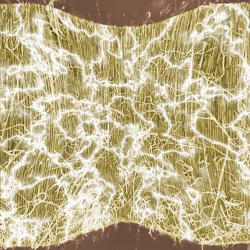Newly designed materials are allowing the creation of devices that generate electricity when they’re squashed or stretched.
The trick is unscrambling the spaghetti of chains of atoms that makes the material up and stacking and ordering them to give this effect. It’s been shown that this can be achieved by forcing the material through a template of tiny holes, one thousand times smaller than the width of a human hair.
Devices using these materials could power sensors on vehicles, machinery, animals, people or even things inside the human body, like pacemakers, where changing the batteries is currently expensive or inconvenient. Since the energy generating component is simply a material rather than an assembly of components, they’re also able to be used in very small or very thin devices, where assembling things is difficult.
These materials are piezoelectric, which means they generate electricity when they’re stretched and also means they stretch when you apply electricity to them. Piezoelectric materials have been known for over 100 years and are used in many everyday things today, including the cigarette lighters that you push a button down to light, where pushing the button is compressing a piezoelectric crystal that results in a spark.
What makes these new materials exciting is that, as well as being piezoelectric, they’re also soft. Most piezoelectric materials are hard solids and many of the best ones contain toxic components. These newly designed materials however are flexible, soft and non-toxic. This makes them exciting for energy generating devices by opening up a lot of new possibilities from the stretchy and squashy nature of the material.
Current research into making further chemical changes to the materials and processing them in increasingly clever ways to make the chains all line up by themselves is making increasing improvements to the material. This development is what will, in the future, allow these materials to be used effectively in devices to generate electricity.
Richard Whiter
NanoDTC PhD Student Cohort 2011
Ferroelectric Energy Materials Group, MaterialsSemiconductor Physics Group, Physics

